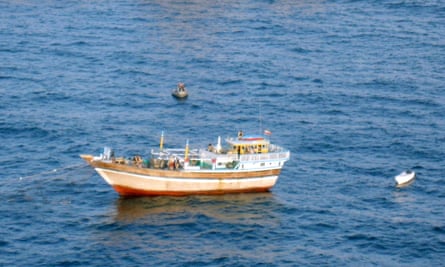Iranian fleet accused of stealing Somalian fish despite acute food shortage


A large fleet of Iranian fishing vessels has been identified operating illegally in Somalian waters for over a year, depleting fish stocks in a country where one in three people face acute shortages of food.
The Somali government, which is unable to police its vast coastline, has expressed concern over food and maritime security and has called on Iran to investigate.
Analysis by Global Fishing Watch, a nonprofit which tracks vessels, and Trygg Mat Tracking, an NGO which provides fisheries intelligence and analysis to African coastal states to help fight illegal, unregulated and unreported (IUU) fishing, suggests it could be one of the largest illegal fishing operations in the world.
The Somali government has shared its analysis with the Iranian authorities and the fisheries watchdog, the Indian Ocean Tuna Commission (IOTC).
Evidence gathered by the NGOs suggests the Iranian fleet could contain 192 vessels, six times the size of the 31-vessel Chinese tuna fleet licensed to fish sustainably in Somalia waters.
They say the Iranian fleet has been operating in Somalia and also in Yemen, from January 2019 until April 2020. Some were discovered fishing close to shore, inside a zone set aside for the nation’s artisanal fishermen.
HE Abdillahi Bidhan Warsame, the minister of fisheries and marine resources of Somalia, called for cooperation from Iran. He said: “Illegal fishing will not be tolerated by Somalia. The situation related to presence of the Iranian fleets in Somali waters, remains a longstanding concern of the Federal Republic of Somalia, and illegal, unreported and unregulated fishing in Somali waters constitutes a significant threat to the food security, economic development, sovereignty and maritime ecology of Somalia.”
Somalia’s 15 million people are currently experiencing multiple threats to food security, including an ongoing desert locust plague and previous droughts which have caused flash floods as well as Covid-19. The UN has warned an estimated 2.7 million people are facing crisis levels of food insecurity, without humanitarian aid, while a further 2.9 million are food stressed.
Somalia has 2,000 miles of coastline, the largest in Africa, but years of civil war and instability has left it unable to effectively police its waters. It is plagued with IUU fishing, which it says encourages piracy.
Since 2018, the nation, part of FishiAfrica, a taskforce of east African countries, the IOTC and NGOs who collaborate to fight IUU fishing, receives $1m a year from fishing licences sold to China. Thirty-one Chinese vessel are licensed to fish outside 25 miles.
Duncan Copeland, the chief analyst at TMT, said he was aware of illegal vessels in the region but his analysis, made possible by the increasing use of collision avoidance software by Iranian ships, shows “the scale is staggering”.
“We are seeing such large numbers of vessels” said Copeland. “It is beyond what any management plan can cope with. It’s way too much fishing effort for the region. It’s going to deplete stocks.”
While reports of widespread illegal fishing in Somalia by Iranian and other vessels has been known about for some time, the scale was unknown until now. Vessels in the region have started using Automatic Identification System (AIS) on their boats and gear, which also allows them to be tracked with satellites
Copeland said the vessels, mostly flagged to Iran, were clearly operating illegally. They also found a smaller number of vessels flagged to Pakistan, India and Sri Lanka.
“Under Somali law, vessels licensed for tuna need to be licensed by the federal government. None of these vessels have been.”
“It is not clear what fishing gear they are using but the signs are they are using drift nets which result in a huge amount of bycatch and that is a big knock-on effect.”
Charlie Kilgour, the director of fisheries analysis at Global Fishing Watch, said the foreign vessels were spotted close to shore, a region Somalia has set aside for local fishermen.
“Some of the vessels can very close to villages and appear to be anchoring. We see boats fishing close to shore. It will have an impact on domestic fisheries. The number of vessels and the number of days spent fishing – 2,533 days – will definitely have an impact on the stock.”
“For them to try to be sustainable and have this going on, it makes all the effort pointless.”
“We hope that Iran and Pakistan will engage with Somalia and the IOTC and work to find a solution to this.”
TMT verified the AIS data from the fleet with satellite imagery of the region. The satellite images revealed the presence of a large number of vessels, some of which were using AIS, while others were not, leading the analysts to believe the actual number of vessels may be far higher than 192.
In a statement, Christopher O’Brien, the executive secretary of the IOTC, said: “The IOTC secretariat does not have an investigative function. Currently the matter is between Somalia and the Islamic Republic of Iran.”
The IOTC has a duty to pass information and intelligence from third parties about alleged IUU fishing onto the flag state of each vessel. If requested by another state, the flag state then has a duty to investigate and report back to the IOTC within 60 days.
Source:theguardian.com/